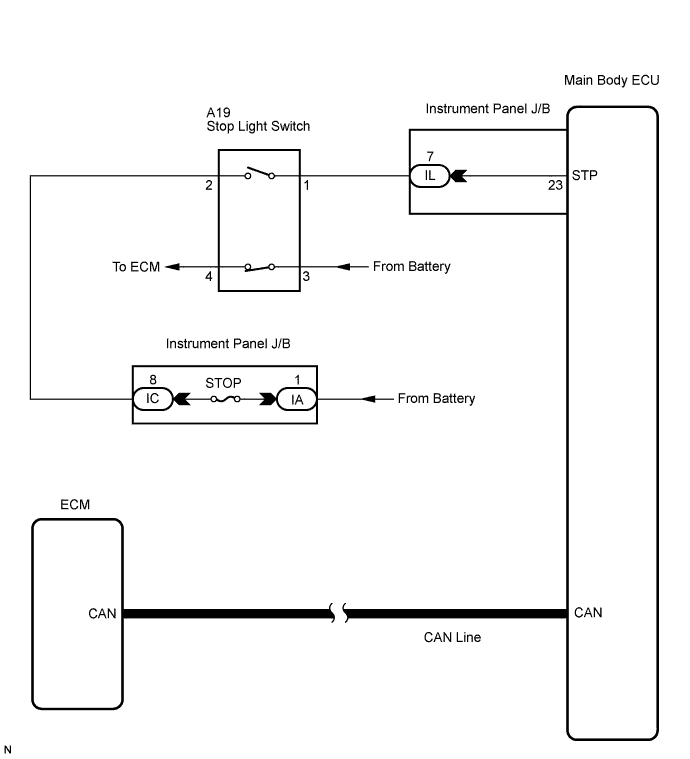Dtc B2284 Brake Signal Malfunction
DESCRIPTION
WIRING DIAGRAM
INSPECTION PROCEDURE
READ VALUE USING INTELLIGENT TESTER (STOP LIGHT SWITCH)
CHECK DTC OUTPUT (CAN COMMUNICATION SYSTEM)
CHECK DTC OUTPUT (ENGINE CONTROL SYSTEM)
INSPECT FUSE (STOP SW)
CHECK HARNESS AND CONNECTOR (BATTERY - MAIN BODY ECU)
INSPECT STOP LIGHT SWITCH
DTC B2284 Brake Signal Malfunction |
DESCRIPTION
This DTC is output when: 1) the brake signal circuit between the main body ECU and the stop light switch is malfunctioning; and 2) the CAN information is inconsistent.- HINT:
- When the main body ECU is replaced with a new one and the negative (-) battery terminal is connected, the power source mode becomes the IG-ON mode. When the battery is removed and reinstalled, the power source mode that was selected when the battery was removed is restored.
- After the main body ECU is replaced, perform the registration procedures for the engine immobiliser system.
DTC No.
| DTC Detection Condition
| Trouble Area
|
B2284
| Communication or communication line is abnormal between the main body ECU and the stop light switch
| - Stop light switch
- CAN communication system
- ECM
- Main body ECU
- Wire harness or connector
|
WIRING DIAGRAM
INSPECTION PROCEDURE
| EMERGENCY ENGINE START CONTROL |
If there is a malfunction in the stop light switch or STOP fuse, their signals may not be correctly transmitted to the main body ECU. This may result in the engine not starting even if the engine switch is pressed while the brake pedal is depressed and the shift lever is in the P position.
To activate the starter:
Turn the engine switch from off to on (ACC).
Press and hold the engine switch for 15 seconds.
- HINT:
- Before performing the inspection, depress the brake pedal and check that the stop lights come on. If the stop lights do not come on when the brake pedal is depressed, refer to the page shown in the brackets (CAMRY_ACV40 RM000002CE201SX.html).
| 1.READ VALUE USING INTELLIGENT TESTER (STOP LIGHT SWITCH) |
Connect the intelligent tester to the DLC3.
Turn the engine switch on (IG).
Turn the intelligent tester on.
Enter the following menus: Body / Body / Data List.
Read the Data List according to the display on the intelligent tester.
Body:Tester Display
| Measurement Item/Range
| Normal Condition
| Diagnostic Note
|
Stop Light SW
| Stop light switch/ON or OFF
| ON: Brake pedal depressed
OFF: Brake pedal released
| -
|
- OK:
- ON (brake pedal depressed) and OFF (brake pedal released) appear on the screen.
| 2.CHECK DTC OUTPUT (CAN COMMUNICATION SYSTEM) |
Clear the DTCs (CAMRY_ACV40 RM000000YEH05QX.html).
Check for CAN communication system DTCs (for LHD: CAMRY_ACV40 RM000000WI605LX.html) (for RHD: CAMRY_ACV40 RM000000WI605KX.html).
- HINT:
- If the DTCs for the CAN communication system malfunction are output, inspect those DTCs first.
- Result:
Result
| Proceed to
|
DTC is not output
| A
|
CAN DTCs are output (for LHD)
| B
|
CAN DTCs are output (for RHD)
| C
|
| 3.CHECK DTC OUTPUT (ENGINE CONTROL SYSTEM) |
Clear the DTCs (CAMRY_ACV40 RM000000YEH05QX.html).
Check for DTC P0500 and P0503 (CAMRY_ACV40 RM000000W8E04DX.html).
- OK:
- DTC is not output.
| | GO TO ENGINE CONTROL SYSTEM |
|
|
Remove the STOP SW fuse from the instrument panel J/B.
Measure the resistance of the fuse.
- Standard Resistance:
Tester Connection
| Condition
| Specified Condition
|
STOP fuse
| Always
| Below 1 Ω
|
| 5.CHECK HARNESS AND CONNECTOR (BATTERY - MAIN BODY ECU) |
Disconnect the IL ECU connector.
Measure the voltage according to the value(s) in the table below.
- Standard Voltage:
Tester Connection
| Condition
| Specified Condition
|
IL-7 - Body ground
| Brake pedal released
| Below 1 V
|
IL-7 - Body ground
| Brake pedal depressed
| 11 to 14 V
|
| | REPAIR OR REPLACE HARNESS OR CONNECTOR |
|
|
| 6.INSPECT STOP LIGHT SWITCH |
Remove the switch (CAMRY_ACV40 RM000001WI400WX.html).
Measure the resistance according to the value(s) in the table below.
- Standard Resistance:
Tester Connection
| Condition
| Specified Condition
|
1 - 2
| Switch pin free
| Below 1 Ω
|
3 - 4
| Switch pin free
| 10 kΩ or higher
|
1 - 2
| Switch pin pushed in
| 10 kΩ or higher
|
3 - 4
| Switch pin pushed in
| Below 1 Ω
|


